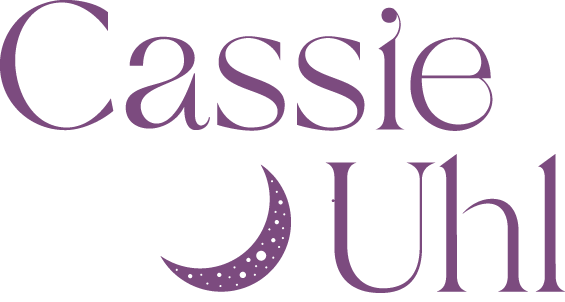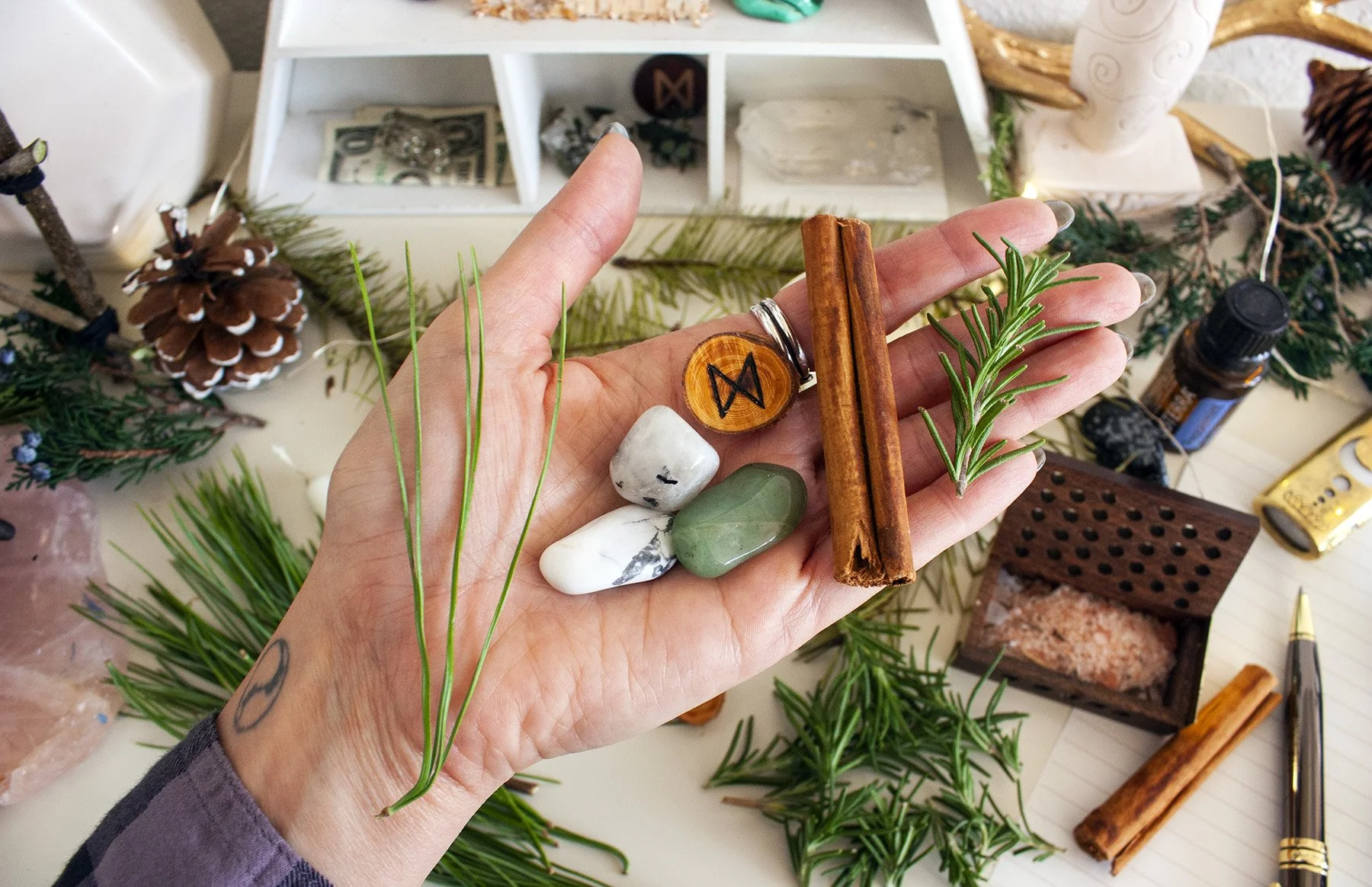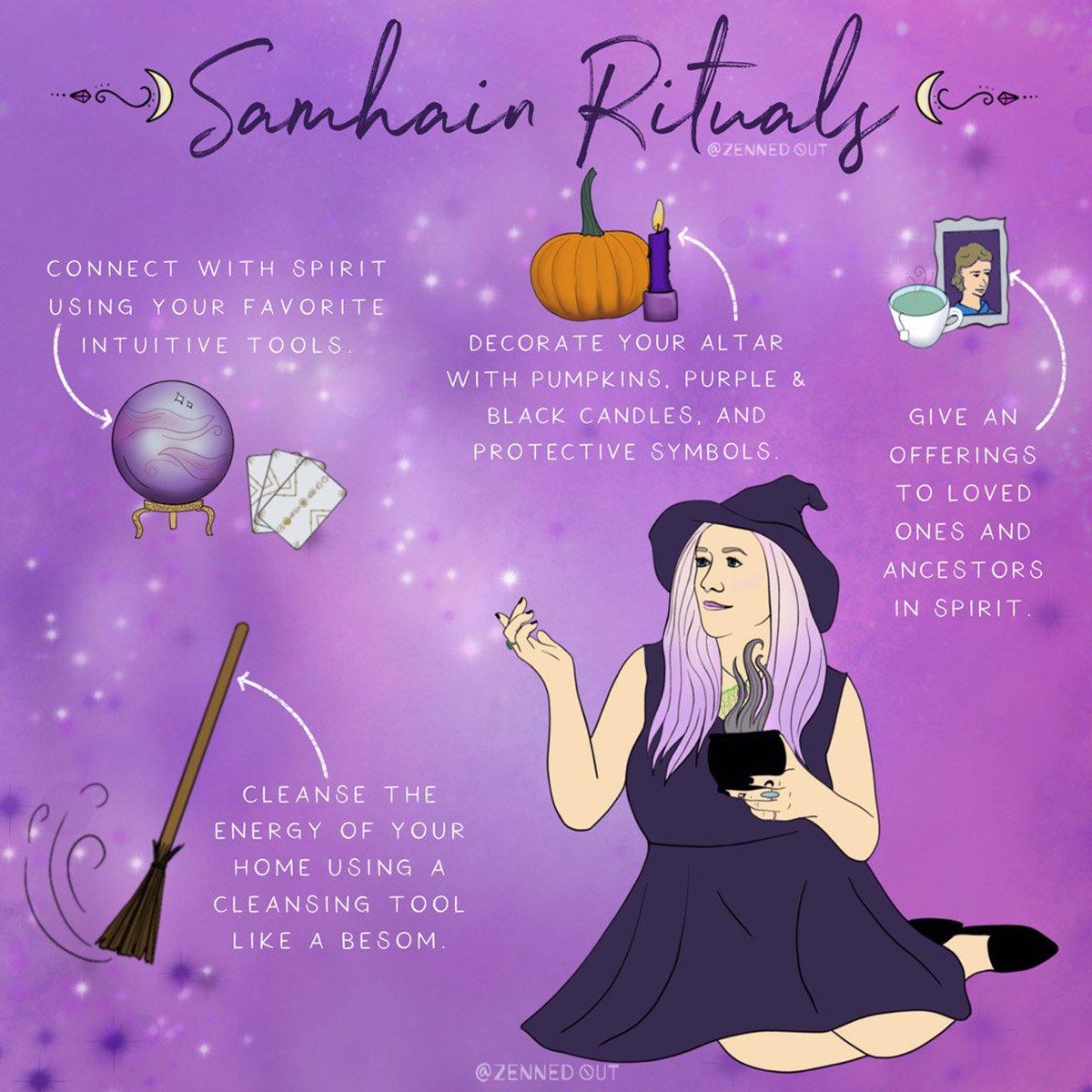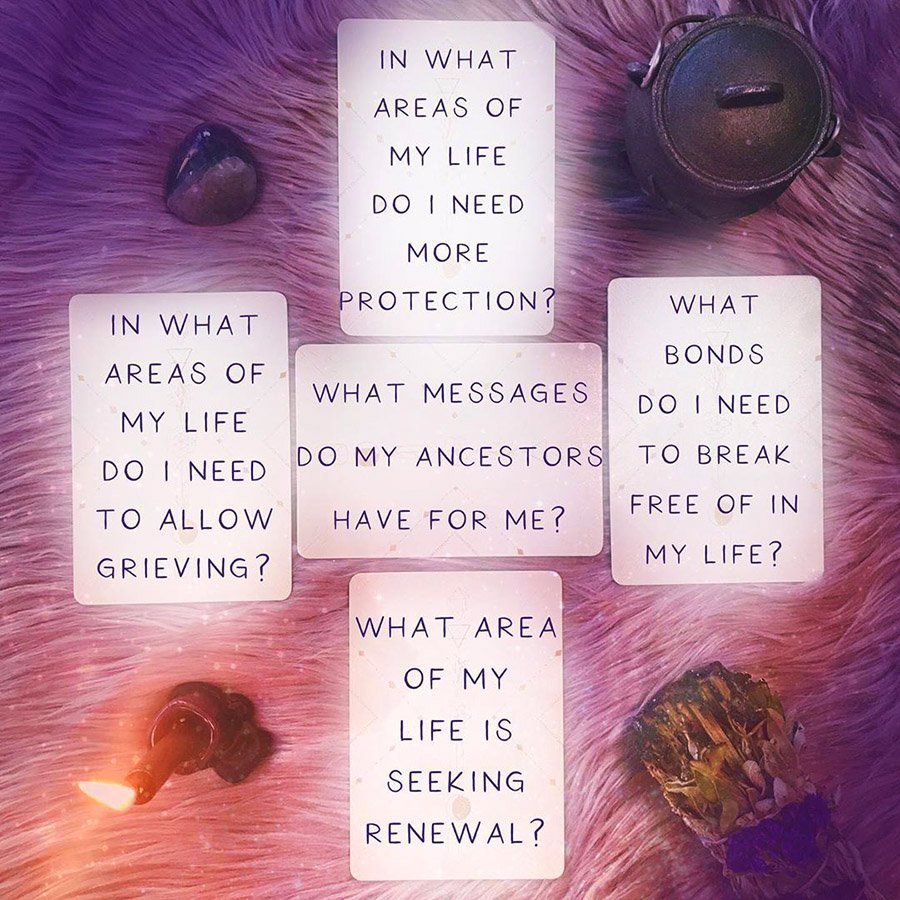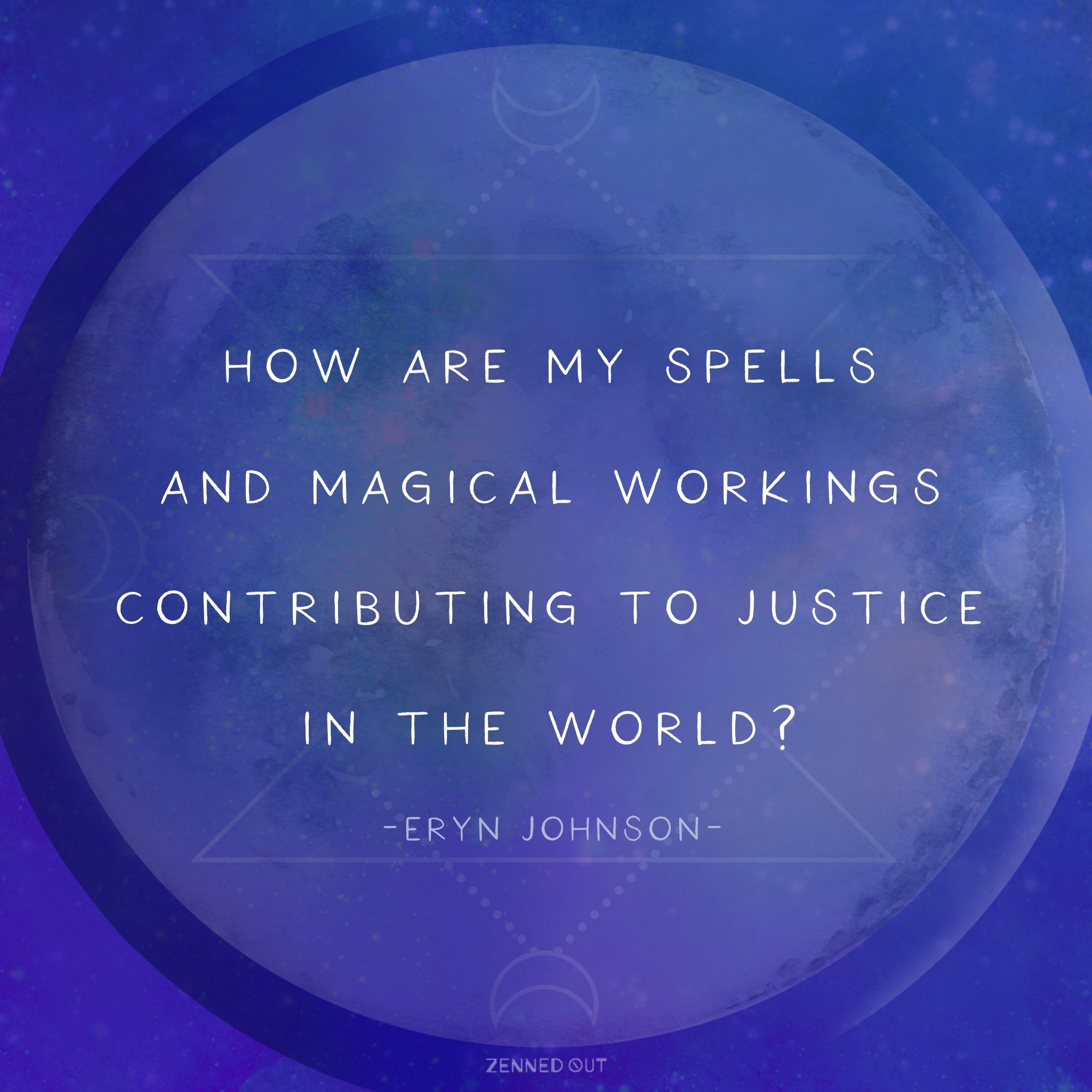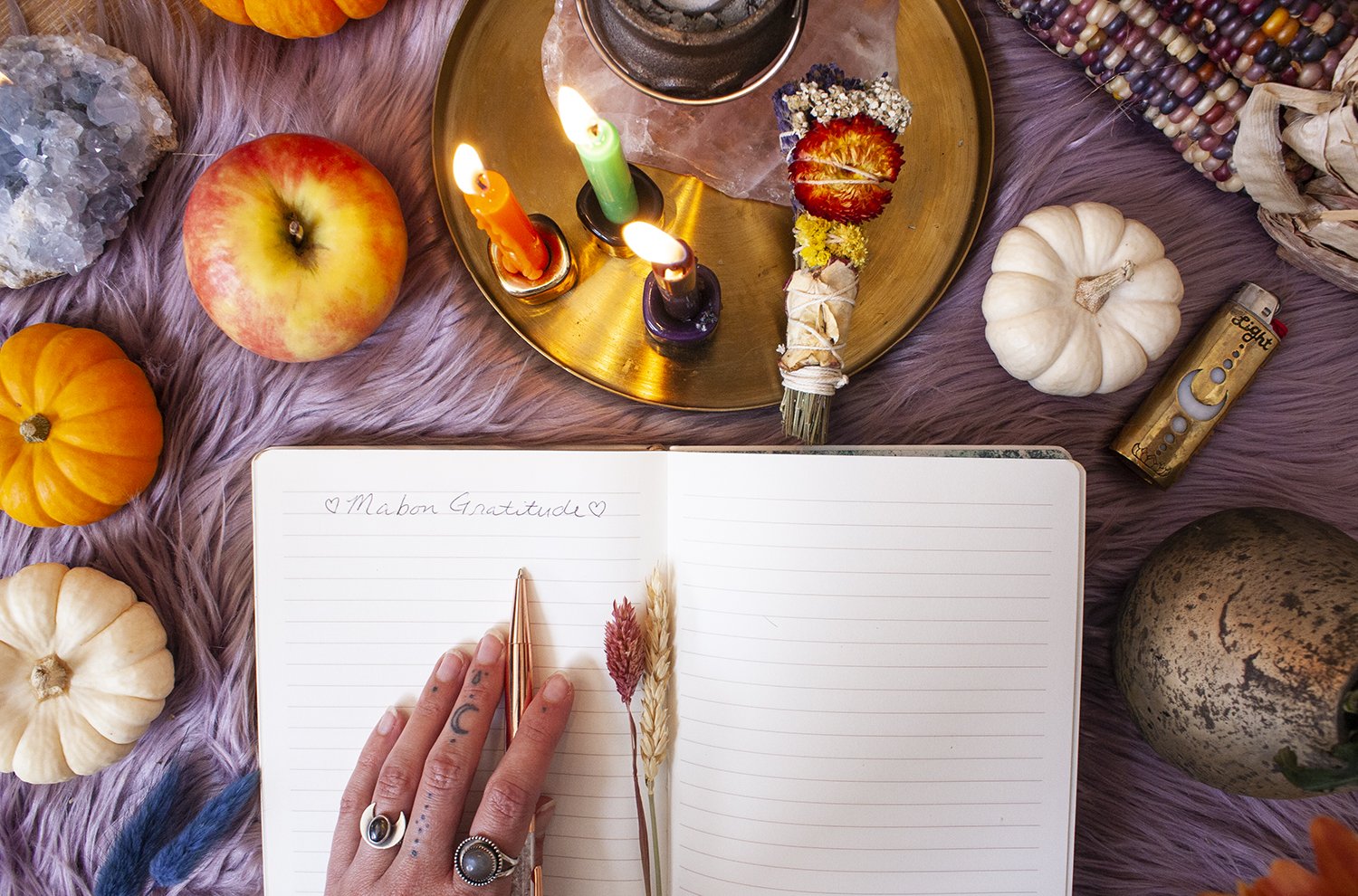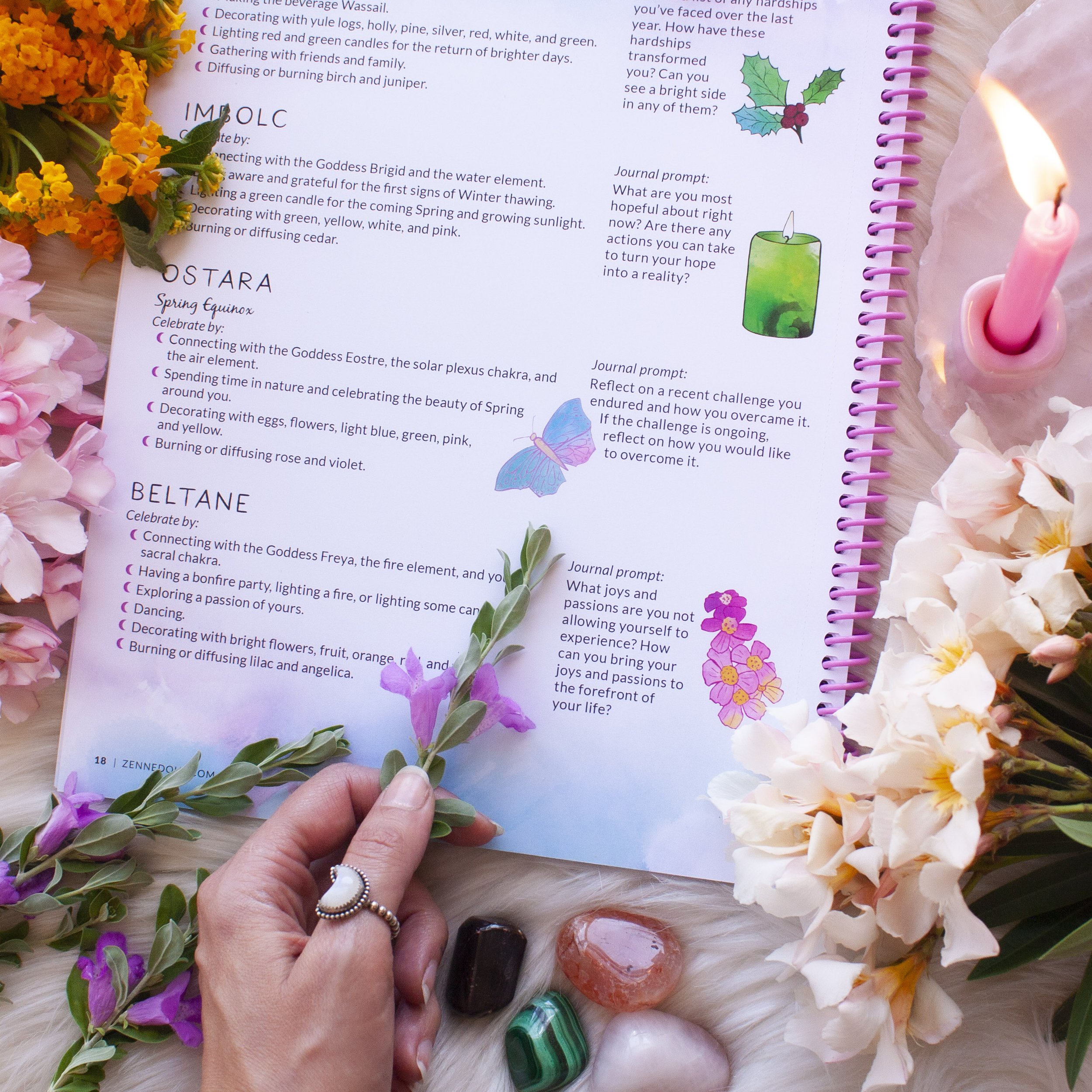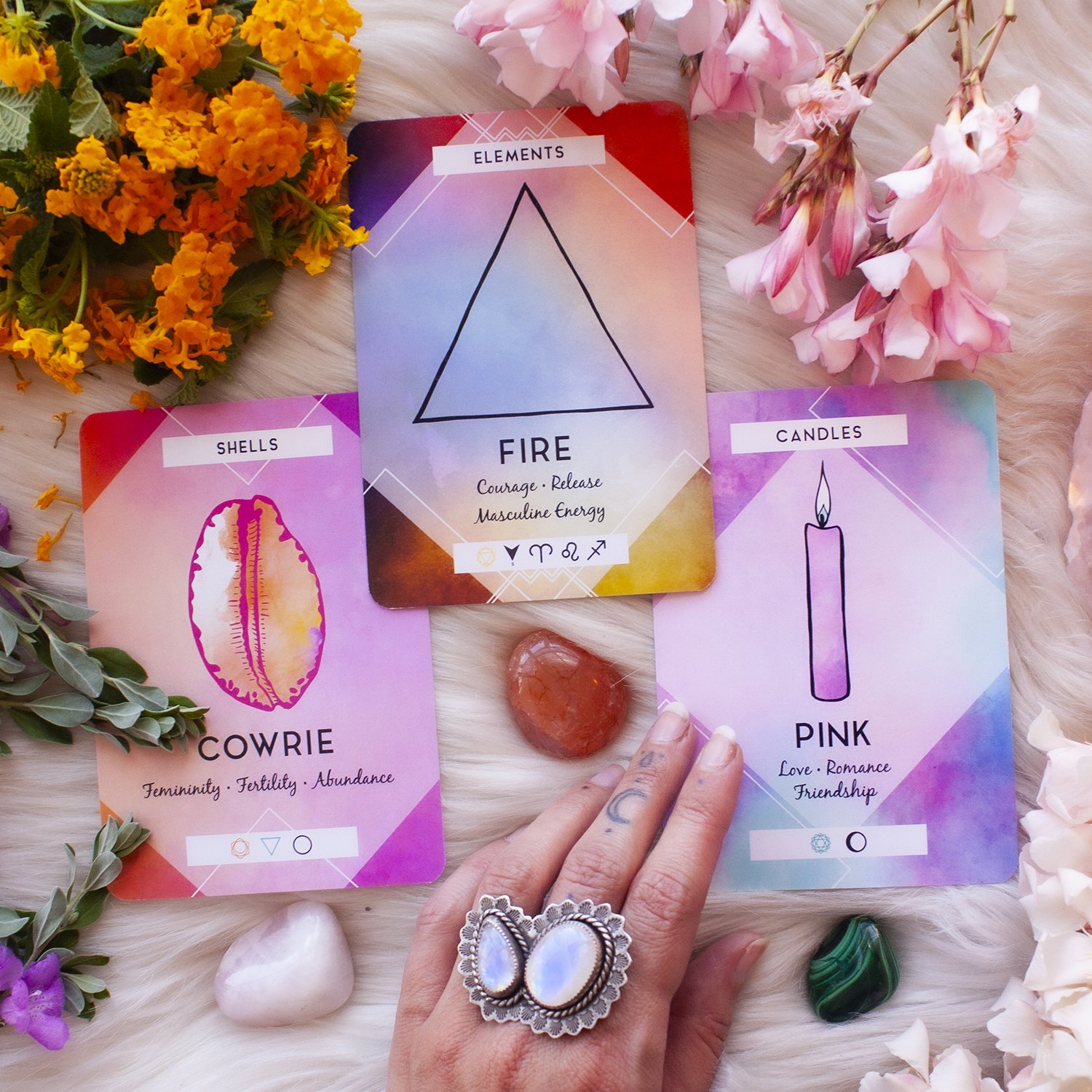Winter Solstice & Yule Spell Jar for Rebirth
The winter solstice, also called Yule in Germanic traditions, is the longest night and shortest day of the year. It is the time we have the most darkness, and after the winter solstice, the sun returns — growing each day.Because of this darkness and the return of the light, the solstice is deeply associated with rebirth. A kind of new year for witches, if you will. In this blog post, I’ll share how to make a DIY spell jar for rebirth in honor of the winter solstice. This would be a great practice to do on the winter solstice or in the days after it! So what are spell bottles or jars? Spell jars are a form of folk magic that can be used for many different purposes. I share more about spellwork below - keep scrolling to read it!
The winter solstice, also called Yule in Germanic traditions, is the longest night and shortest day of the year. It is the time we have the most darkness, and after the winter solstice, the sun returns — growing each day.
Because of this darkness and the return of the light, the solstice is deeply associated with rebirth. A kind of new year for witches, if you will. In this blog post, I’ll share how to make a DIY spell jar for rebirth in honor of the winter solstice. This would be a great practice to do on the winter solstice or in the days after it!
So what are spell bottles or jars? Spell jars are a form of folk magic that can be used for many different purposes. I share more about spellwork below - keep scrolling to read it!
A LITTLE ABOUT SPELLWORK
To me, spells are about directing energy in a specific direction. They’re about using magick, which Dion Fortune defines as “the art of changing consciousness at will,” for healing, manifestation, and connection.
I believe that they can be simple, and all you really need is yourself and your energy. Other items, like the ones we’ll use in this spell, are supportive in infusing some extra magick and energy into the work — but you don’t need them to do spells.
WHAT YOU’LL NEED
For this spell, you’ll need:
As with all spells, use what you have. Feel free to substitute items, and don't worry if you're missing something from this list. Your intention is the most important part of any spell!
A glass bottle/jar of any size
Salt of any kind for protection
A piece of paper and pen to write your intention
3-5 drops of oil that supports rebirth like eucalyptus or peppermint
Stones that represent rebirth to you like moonstone, green aventurine, and howlite for peace as you transform. Other stone options could include malachite, citrine, moss agate, or quartz.
Dried or fresh herbs that support rebirth like spruce, pine, or nettle.
Dried or fresh rosemary for clarity and protection.
Cinnamon stick for luck
Dagaz rune, which represents dawn. This can be placed inside your jar or drawn/painted on the outside of your jar.
White candle
Any other representations of rebirth for you
Let yourself be intuitive with your spell ingredients, and feel free to use what you have around you!
SPELL STEPS
Like any spell, you’ll want to center and ground yourself before working the spell. You might spend a few minutes meditating, letting your eyes drift around your space, or doing breathwork or anything else that feels grounding to you. Find ideas for grounding here.
When you feel ready, cleanse each of your items. You can use smoke, sound, salt, or another cleansing technique you align with.
Write your intention for the spell on the paper to add into your bottle.
If you’d like, you can paint your bottle with symbols that represent rebirth to you.
After your bottle is ready, take your time to place each item inside your bottle intentionally. Raise energy as you do this, either with deep breaths or chanting. I recommend coming up with your own chant that focuses energy on connecting to your intuition and developing your intuitive abilities.
When you’re done filling your bottle, seal it, hold the vessel in your hands, and keep chanting or breathing as long as you’d like.
Light your white candle and place it on top of or next to your spell bottle. Be mindful of your candle surroundings and never leave your candle burning unattended. Tip: Melt the bottom of your candle with a flame to make it stick to the top of your jar.
Spend time meditating on your intention as your candle burns. Connect with the feeling of rebirth. Visualize rebirth moving through your cells, making you whole. What would it feel like, look like, even sound like, to be reborn?
Ground the energy after your meditation by placing your palms on the ground and returning any excess energy to the Earth.
I recommend placing the bottle on your altar, keeping it at the forefront of your consciousness while it works its rebirth magic. Keep your Yule spell bottle out for one lunar cycle, until Imbolc, or when you feel ready to take it down.Want more ways to connect with the season of Yule? Check out these articles from our blog:
5 Samhain Rituals + Samhain Correspondences & Card Spread
The ancient Celtic celebration of Samhain (pronounced sow-in), celebrated on October 31st and November 1st, marks the end of our seasonal cycle on the Wheel of the Year. This is why it's often referred to as the witch's New Year. Seasonally speaking, Samhain is the third and final harvest of the season or the last rally to store and prepare for the coming Winter season.This sacred celebration reaches much farther than harvests and is also a time when the veil between the physical and spirit world is at its thinnest. The Celtic people believed that spirits walked among them during this time, so Samhain is accepted as an ideal time to communicate and connect with the spirit realm.
The ancient Celtic celebration of Samhain (pronounced sow-in), celebrated on October 31st and November 1st, marks the end of our seasonal cycle on the Wheel of the Year. This is why it's often referred to as the witch's New Year. Seasonally speaking, Samhain is the third and final harvest of the season or the last rally to store and prepare for the coming Winter season.
This sacred celebration reaches much farther than harvests and is also a time when the veil between the physical and spirit world is at its thinnest. The Celtic people believed that spirits walked among them during this time, so Samhain is accepted as an ideal time to communicate and connect with the spirit realm. Here's a fun drawing I created with ritual suggestions for Samhain. Keep scrolling to learn more about each one.
Time to pull out all of your favorite intuitive and protective tools! Let's dig into four different ways to connect with this season through ritual. I'll also share correspondences for Samhain and a card spread to use with your favorite tarot or oracle card deck.
1. Create a Samhain Altar + Samhain Correspondences
Switching up your altar or sacred space for the seasons is an easy way to bring in each celebration's energy on the Wheel of The Year. Get a quick look at how I do this in this video I shared on Instagram for Mabon.
When it comes to changing out your altar, understanding the correspondences (items that carry the similar energy) of Samhain will be helpful. Here's a list of tools and symbols that correspond with Samhain.
Samhain Correspondences:
Themes: Releasing, cleansing, divination, protection, the underworld, offerings for ancestors
Moon Phase: Waning crescent moon
Crystals: Labradorite, obsidian, onyx, garnet, hematite, amethyst
Candle Colors: Purple, black, orange, silver
Tools: Besom (broom), cauldron, any kind of divination tool
Plants and Scents: Mugwort, cinnamon, clove, patchouli
Foods: Apples, pomegranate, pumpkins, nuts, meat
Runes: Algiz, Daggaz, Ansuz, Perthro, Othalo
Gods and Goddesses: Persephone, all crone Goddesses, Callieach, Cerridwen, and Hecate
To create your altar, select items and symbols from the list above and anything else that personally connects you to this season. Clear and cleanse (both physically and energetically) your altar space, then place your altar items with care and intention. I like to end my altar creation by lighting a candle and saying a prayer for the altar's intention. It could be something like this, but feel free to tailor it to your liking.
With this altar, I welcome the final harvest season and the thinning of the veil. I remember my loved ones crossed over and all ancestors before them and share this offering as a sign of my gratitude. Myself and my space are protected from any beings that do not have my highest good in mind. So it is.
2. Sweep away negative energy with a besom
With the thinning of the veil between spirit and physical, it's essential to clear out and protect your space from unwanted energies. I shared a thorough post a few years ago with steps to perform a Samhain house cleansing and blessing; check it out here. Because I already wrote all about performing a house cleansing, I'd like to dive a little deeper into using a besom for Samhain.
A besom, or broom, is a tool used by witches to cleanse a space energetically. Though your besom can clean physically, it doesn't touch the ground when used as an energy cleansing tool. Simply open a door in your house, sweep right above the floor, and visualize negative energy leaving your space.
You can make your besom or find them for purchase at certain stores. I usually get mine from Trader Joe's and like to add my own decorations to it.
3. Connect with your ancestors and give offerings to loved ones in spirit.
There are cultures worldwide who believe that our loved ones come back at certain times to walk among us. We see this in the Dia de Los Muertos in Mexico, Hungry Ghosts day in China, and in Samhain (to name a few.)
Samhain offers us a special time to connect with, honor, and remember all those who have come before us. You can do this in various ways, including by connecting with your ancestors for guidance through your intuition, remembering loved ones and ancestors passed on, or giving loved ones in spirit an offering.
Your altar is a great place to give an offering to any loved ones who've crossed over. An offering to your ancestors could be pictures of them or favorite foods and drinks. You can also connect with ancestors in spirit through meditation and breathwork. Check out this past blog post for steps to work with your ancestors through meditation and breathwork.
Find a guided journey to your ancestors here.
4. Protect yourself!
The thinning veil is a double-edged sword for Samhain. Yes, it is lovely to connect with spirit so easily, but it also leaves you more susceptible to all energies, which may not have your highest good in mind. Because the veil is so thin during this time, take care to protect yourself and your space from any unwelcome energy.
The featured oracle card deck is The Ritual Deck.
A protection tool that works exceptionally well during Samhain is burning dried mugwort. I shared all about this plant here. Some other favorites are salt for banishing, black candles, and the Rune Algiz. Find even more protection tools and rituals in a previous post here.
5. Pull out your intuitive tools + Samhain Card Spread
If you want to connect with spirit, set the wheels in motion for a new desire, or want to learn more about yourself from a higher perspective, now's the time to pull out all the stops and dive deep into your intuitive practice. With the thinning veil between spirit and physical, the doors are wide open for profound intuitive growth, shadow work, and spiritual connections.
Here's a suggested card spread to try out with your favorite tarot or oracle card deck. Samhain tarot or oracle card spread.
In what areas of my life do I need more protection?
What bonds do I need to break free of in my life?
What areas of my life are seeking renewal?
In what areas of my life do I need to allow grieving?
What messages do my ancestors have for me?
There are endless options for performing intuitive work, but some of my favorites for Samhain are candle spells, scrying, oracle and tarot card readings, and journey work.
Samhain is a truly magical time, and I hope you can feel how special it is with everything I've shared here. Remember, there's nothing to fear. At our core, we are spiritual beings too. This unique time offers us the opportunity to connect with a realm we already know so well, even if we've temporarily forgotten. Samhain blessings, dear one!
Spellwork and Witchcraft Ethics
When we understand how powerful witchcraft and spellwork can be, we know that there is as much potentiality for causing harm as there is for healing.I don’t believe that ethics in this area (or any, really) are black and white or something that can be written in a post and passed right along to you. I think ethics are both nuanced and personal. So in this blog, I’ll be sharing a bit of my own thoughts about spellwork and witchcraft ethics, and offering some different areas of reflection for your own spellwork and witchcraft ethics.
When we understand how powerful witchcraft and spellwork can be, we know that there is as much potentiality for causing harm as there is for healing.
I don’t believe that ethics in this area (or any, really) are black and white or something that can be written in a post and passed right along to you. I think ethics are both nuanced and personal.
So in this blog, I’ll be sharing a bit of my own thoughts about spellwork and witchcraft ethics, and offering some different areas of reflection for your own spellwork and witchcraft ethics.
CULTURAL APPROPRIATION + CONSUMPTION
Ijeoma Oluo, author of So You Want to Talk About Race, wrote for Medium, “Cultural appropriation is the misuse of a group’s art and culture by someone with the power to redefine that art and, in the process, divorce it from the people who originally created it.”
Cultural appropriation is rampant in the spirituality, new age, and witchcraft communities. Sacred indigenous plants are bought and sold by white folks, indigenous knowledge is whitewashed, repackaged and sold, and practices are stolen from cultures of color.
The impacts of cultural appropriation are not just personal, they widely function to continue to funnel power towards white folks and away from Black folks, Indigenous folks, and other people of color.
I also personally feel that working with tools and practices from our own ancestry are always going to be more powerful than working with tools and practices that are not from our own ancestry!
Some reflection questions for your own practice around cultural appropriation:
What tools are you using in your magical practice, and where do they come from? If they are from cultures other than your own, how are you giving back, uplifting and supporting those cultures and peoples?
Are they sourced in ways that feel good to you and aligned with your values (for example: are your crystals mined by children? Are trees being chopped down for your Palo Santo?)?
What are the lineages of the practices you use? If you don’t know, do some research.
How were your ancestors practicing witchcraft and magic? What are their traditions? What tools were they using? What were there beliefs? (These are big questions and incredibly important ones, especially for white folks to be asking. It can be hard to find information when much of European folk magic traditions were stolen by Christianity when the religion swept over the continent, but it’s out there. To start ancestral research, I recommend checking out Sanyu Estelle’s Ancestral Altars: Europa Edition recorded class as well as Megan McGuire’s work. Cassie also loves Elen Sentier’s work on British Shamanism.)
CAUSING HARM WITH MAGICK
Just as we can do spellwork to attract love and abundance, we can also practice curses, hexes, and other kinds of spellwork to manipulate and cause harm to others.
It would be easy for me to tell you here: never use curses or hexes, never practice magic that causes harm. There are Wiccan creeds around this that you may be familiar with, the Threefold Law and the Wiccan Rede.
The Threefold Law states that whatever energy you put out will come back to you times three. The Wiccan Rede states “An it harm none, do what ye will.” There are different ways to interpret the Wiccan Rede, but most agree that it means as long as your workings harm no one, do what you feel called to.
I tend to agree with these ideas personally, but it’s not so black and white. Some Black magical traditions like Hoodoo have no such rules and use cursing and crossing in alignment with their own ethics. I think it’s important to stay in my own lane when it comes to passing blanket statements about what it is and isn’t okay to do with magic, when there are deeply rooted traditions that incorporate some of these practices.
We can expand this out and ask, too — is it truly unethical to curse or hex a person who does evil in the world at a large scale?
I don’t have answers for you, but I invite you to reflect on these questions. What settles in your body and heart when it comes to causing harm with magick?
JUSTICE
This brings me to justice. Witchcraft is intrinsically linked to justice and is inherently political, no question about it.
I invite you to ask yourself: how are my spells and magical workings contributing to justice in the world? Or are they functioning to amplify privilege and get only myself ahead?
One of my favorite practices around this was shared by Amanda Yates Garcia, the Oracle of LA. She invites us to send out any spell we do for ourselves for the collective, too. For example, a spell to attract money would also include something like, “as it is for me, as it is for all,” to ask the spell to attract money for all of us. A spell for a new home for yourself might include housing justice for all. A spell for a lover for yourself might include safe and healthy relationships for all. And so on!
CONSENT
One of the key principles in energy work is always getting consent. Energy work has real impacts, and people deserve the opportunity to be able to opt-in to receive it.
For me, this is true regardless of our best intentions - even if we want to send healing to someone we don’t know (who can’t consent) because we think it would really help them.
What is true for you? Ask yourself: what are my consent boundaries with others when it comes to energy?
As you can see, ethics is a murky field but an important one to consider for any witch! My advice is: Work from your own value system. If you’re not clear on what your values are, start there. Let your witchcraft practice reflect your ethos, and know that we all have different values & ideas of what is right or wrong.
At the end of the day, we all have to be able to sleep at night from a place of knowing the truth, not from ignorance of the impacts of our actions. What do you need to change or lean into in your practice to make that so?
3 Rituals for Mabon
Mabon, also known as the fall equinox, is the holiday on the Wheel of the Year that descends us into autumn. On this day, as with both equinoxes, light and dark find balance — we hover, suspended, at an even keel before tipping into more darkness.When we fear darkness, this descent may feel scary. But intentionally working with the seasons and the Wheel of the Year can teach us the inherent goodness in every season, and the necessity of each point in the year.
Mabon, also known as the fall equinox, is the holiday on the Wheel of the Year that descends us into autumn. On this day, as with both equinoxes, light and dark find balance — we hover, suspended, at an even keel before tipping into more darkness.
When we fear darkness, this descent may feel scary. But intentionally working with the seasons and the Wheel of the Year can teach us the inherent goodness in every season, and the necessity of each point in the year. Without the fall and winter dying season, there can be no space for growth in spring and summer.
Without the pruning and reevaluating of the dying season, the growth season brings overwhelm and lack of focus. Without the shadow work fall and winter invite in, spring and summer feel shallow — love and light with no substance. Working with ritual is a beautiful way to honor this sabbat. Scroll down to explore some rituals to inspire your practice for this sacred day and season.
Gratitude Ritual
Often referred to as the Witches’ Thanksgiving, Mabon is thought of by some as a second harvest time. A time to reap what you have sowed, and enjoy the fruits of your energy with those you love.
This gratitude ritual is inspired by this aspect of Mabon. All you’ll need is a candle in a color that connects you to gratitude, a piece of paper and a pen. You can make this fancier if you’d like by rolling your candle in oil and herbs (here are a few gratitude herbs shared by Yoga International to check out), but it’s definitely not a requirement.
Ground yourself and spend some time reflecting on the question: what are you grateful for? Think back throughout this whole year, perhaps since the last fall equinox, and free-write everything you can think of on your paper.
Maybe there’s even enough time and space from some of the harder things of the past year to find some gratitude in them (or maybe not, and maybe there never will be, and all of that is okay, too!).
When you feel complete with your list, light your candle and start reading aloud everything you’re grateful for. Take a breath and pause with each item to really feel the gratitude move through your body, to consciously connect with this energy. Depending on how long your list is and how you’re feeling, you might read your list a few times.
Then, raise energy in a way that feels joyful to you - it could be dancing, shaking your whole body, laughing, or anything else that feels good to you! Let gratitude soak into your cells. Let it infuse your body with love. When you’ve felt the energy shift, burn your gratitude list on your candle and offer up a little gratitude prayer that feels good to you — I like something simple like, “thank you, more please!” to share my gratitude and offer to the Universe that I’m open to receiving more things to be grateful for.
Let your candle burn out, or burn it for the next few days and sit in a short gratitude meditation each day while you do.
Make an Altar
Making a seasonal altar is a lovely and tactile way to honor any season. To make your altar, ask yourself: what textures, scents, images, archetypes, symbols, and items evoke a feeling of autumn for you?
Check out this video from our Instagram page for tips on resetting your altar for the seasons.
Here are some suggestions to inspire your practice, but I highly recommend letting your altar creation be intuitive:
Sticks and/or leaves from the land near you
The High Priestess tarot card, symbolizing Persephone’s descent into the underworld
Local seasonal fruits and vegetables like apples, grains, and squash as offerings for ancestors
Autumnal colored candles — brown, red, orange, and/or yellow
Pomegranates, which also symbolize descent into the underworld
Try to be as present as possible while creating your altar to really sink into the space you’re creating. After you’ve set up your altar, try spending a few moments meditating on the themes of Mabon and intention of this holiday.
Ritual to Descend into Darkness
This ritual is to be done outside at sunset (if that’s possible for you, if not, you could change it to be inside and view the sunset through a window) on the fall equinox.
Set yourself up for a pleasurable and safe sunset viewing experience, whatever that means to you! If it’s chilly, maybe you need a sweater and thick socks. Maybe you like to have yummy snacks and a drink, or a journal to write a poem about the sunset beside you. It’s up to you!
Watch the sunset and try to be as present as possible. Notice how the sun’s energy makes you feel, and how that might shift as the sun continues to sink lower and the colors change across the sky. As the sun sets, offer gratitude to the sun for its life-giving energy.
Sink into the darkness, and try to be as present as possible with it, too. Notice how your energy and the sensations and feelings in your body shift with the darkness. Ask yourself: what are the gifts of this darkness? What’s the medicine, the magic? Notice what you hear, smell, see - maybe it’s bugs singing, the stars in the sky, a smoky scent of someone’s backyard fire pit.
Speak words of love and praise aloud to the darkness. Share what you love about it. What you’re ready for. What calls to you about the darkness. If you feel called, leave an intuitive offering out for the darkness — food, a poem, a painting, a flower, anything that feels good to you.
Close your ritual with a few deep breaths, and spend some time journaling after to process your experience.
Happy Mabon! Sending you lots of love and wishes for a nourishing fall season from team Cassie Uhl. Find more rituals for Marbon here.
5 Rituals for Lammas & Lughnasadh
Lammas, or Lughnasadh, is one of the four cross-quarter days on the Celtic Wheel of the Year. This holiday, celebrated by ancient European pagans, marks the beginning of the harvest season. The name Lughnasadh comes from “Lunasa,” which means August in Gaelic. Lammas is the English word for this harvest festival, which is Anglo-Saxon for “loaf mass.” I tend to use both names, as I have both Irish and English ancestry.
Lammas, or Lughnasadh, is one of the four cross-quarter days on the Celtic Wheel of the Year. This holiday, celebrated by ancient European pagans, marks the beginning of the harvest season.
The name Lughnasadh comes from “Lunasa,” which means August in Gaelic. Lammas is the English word for this harvest festival, which is Anglo-Saxon for “loaf mass.” I tend to use both names, as I have both Irish and English ancestry.
At the beginning of the harvest season, the themes of this holiday are abundance, gratitude, harvest, and honoring the fruits of our labors and intentions throughout the year thus far.
Honoring the sabbats with ritual is a beautiful way to tune yourself into nature and connect with Mother Earth. Scroll down for 5 Lammas rituals to help you celebrate this day!
Meditate to connect with Lugh. This holiday is associated with the sun god Lugh (which you can see in the name Lughnasadh). Lugh is a warrior deity in Celtic mythology known for being skilled in many things, including fighting, building, and the arts.
For this ritual, sit in meditation (ideally, outside under the sun if that’s possible for you) and ask to connect with the energy of Lugh. In my practice, I like to work with deities energetically as archetypes that are already within myself, but please, do whatever works for you! You can ask Lugh to share a message with you, ask him to share his skills in a specific area you need help with, simply offer him gratitude, or bring forward another question specific to you.
Bask in Lugh’s energy until you feel complete, offer gratitude, and close your meditation with a few deep belly breaths.
You can find a meditation for Lughnasadh here to help you harvest the fruits of your labor over the previous year and tune into the energy of pride.
2. Explore what you are harvesting in your life at this time. Try this tarot or oracle card spread for deeper clarity around the abundance in your life right now.
What I am harvesting at this time
The roots of this harvest (aka, what happened to make this harvest possible internally and externally?)
How to step into the energy of gratitude
How to continue to create abundance in my life
Spend some time meditating with your cards or journaling about their meanings to go deeper.
3. Support local farmers. I love when ritual becomes tangible and infused with life, and this is one of those rituals! Ask yourself how you can support local farmers in your life. Perhaps you’d like to commit to doing a CSA next year or buying some portion of your food locally. Perhaps you can go to the farmer’s market, purchase some things and get to know your local farmers. Get creative and support those who make our physical harvest possible every day.
4. Bake a loaf of bread. Associated with grains, this is the perfect day to bake a fresh loaf of bread. Do this with loved ones if you’d like for a more collaborative process, and infuse intentions of gratitude and abundance into the baking process. Share the bread with your loved ones afterward, and talk about what the themes of this holiday mean to you.
5. Make an altar. Making an altar is a beautiful way to honor any sabbat. Get creative and make it your own! To inspire your own creativity, here are some ideas of things you might like to put on your altar:
Bread or grains
Yellow, orange, red, or brown candles
Local, seasonal fresh vegetables
Your tarot cards from the spread above
The 8 of Pentacles, 10 of Pentacles, or any other cards that represent harvest, abundance, and gratitude to you
An ear of corn
Sunflowers
Citrine, pyrite, or tiger eye
To learn more about the different sabbats on the wheel of the year (plus, get a free printable), click here. Learn more about the intersection of the first harvest season, Leo season, and Lughnasadh and the history of the Celtic God Lugh here.
Three Rituals for Beltane
Beltane is a cross-quarter holiday on the Wheel of the Year that honors the return of summer, the return of the fertility of the Earth, and the element of fire. It’s a nature-based holiday that many of our ancestors celebrated for a long time, and now we get to carry that tradition forward. Like Samhain, Beltane is a time when the veil is thin. This holiday is a particularly beautiful time to connect with nature spirits, as well as any other beings you’re wanting to create a connection with. At Beltane, we honor the goddess as part of us. We honor the body, pleasure, sensuality, and sexuality. We bask in the fiery energy of the sun and the fertile energy that’s present. In this blog, I'm sharing three rituals and suggested tools for Beltane that you can work with to honor this sacred holiday.
Beltane is a cross-quarter holiday on the Wheel of the Year that honors the return of summer, the return of the fertility of the Earth, and the element of fire. It’s a nature-based holiday that many of our ancestors celebrated for a long time, and now we get to carry that tradition forward.
Like Samhain, Beltane is a time when the veil is thin. This holiday is a particularly beautiful time to connect with nature spirits, as well as any other beings you’re wanting to create a connection with.
At Beltane, we honor the goddess as part of us. We honor the body, pleasure, sensuality, and sexuality. We bask in the fiery energy of the sun and the fertile energy that’s present.
In this blog, I'm sharing three rituals and suggested tools for Beltane that you can work with to honor this sacred holiday. Keep scrolling to watch a video and read more!
Page featured from the Goddess Discovery Book V2
OPTIONAL RITUAL TOOLS FOR BELTANE
Feel free to add any of the symbols and tools outlined below to your Beltane rituals or altar. They each correspond with the energy of Beltane. They are not necessary and should be viewed as optional layered energy in your rituals.
Cards featured from The Ritual Deck.
Crystals: Rose quartz, garnet, pink tourmaline, rhodochrosite, emerald, malachite, and moonstone
Scents and plants: Sandalwood, ylang-ylang, lilac, angelica, jasmine, and rose
Candle colors: Pink, orange, and red
Element: Fire
Tarot: Empress
Rune: Berakno
Goddess: Venus/Freya
Tools and Symbols: Cowry shell, flowers, and anything that represents pleasure and creativity to you
Learn more about these rituals for Beltane with Eryn by clicking the video below.
PLEASURE RITUAL FOR BELTANE
This is one of my favorite pleasure-based rituals, and there’s no time like Beltane for it! You’ll need:
An oil that you’re comfortable using on your skin, like coconut oil or sunflower seed oil (feel free to mix in any essential oils that intuitively feel good to you as well! Ylang Ylang, rose, and sandalwood are great options.)
Music (optional)
A journal (optional)
If you’re using music, take some time to create an intentional, sensual playlist. What songs make you feel really juicy and embodied?
When you’re ready, get yourself into a cozy space, turn your music on if you’re using it, and start to anoint yourself with the oil. Take your time to gently massage the oil into your skin. Keep your breath deep and full, giving yourself sensual touch and really letting yourself receive it.
As you breathe and anoint yourself with the oil, really tune in to the sensation of this touch. Try to stay present and tap into feeling good. We are generally so touch-starved in our lives, and giving ourselves loving touch can be really special.
At some point, this ritual might move into some organic, embodied movement. Or it may not! Feel free to follow whatever feels right here, but keep tuning into your senses and breathing deeply. Some mantras or affirmations might arise organically that you’d like to offer yourself, or perhaps you start to just rest with your hands on your belly and heart.
Close this ritual with a few loving breaths, reach for your journal and hold some space for yourself to process your experience and think about your relationship with pleasure.
SELF-LOVE RITUAL FOR BELTANE
Traditionally, folks would jump over fires at Beltane to strengthen a bond, increase fertility, and/or attract a partner. Any and all of those intentions are beautiful, but I’m most interested in connecting with our own love for ourselves at this time. For this ritual, you’ll need:
A mirror
A candle with a very stable base (rather than a traditional spell candle, try to use a votive or a short candle in a glass container. You’ll understand why as you keep reading!)
When you’re ready, soften into a cozy, ritual space. Place your hands somewhere on your body to ground and open your circle, and find your breath. Drop into meditation, and start to breathe into a simple phrase: “I love you.”
Notice what starts to happen in your body as you keep telling yourself this (silently or out loud). You may find yourself entering a trance. You may feel a rush of loving energy, a flood of shame, feelings of inauthenticity, or something completely different. Just notice, with compassion, how your internal world shifts as you continue to meditate on this phrase. If another phrase around love comes up for you, you can start to work with that as well.
Follow your intuition and follow the threads. Perhaps a specific version of you or a part of yourself you feel ashamed of arises to the surface. Can you give that part of your self love, too? Perhaps a critical voice comes up, judging you and your practice. Can you be with that part of yourself, too, and give it love?
Stay with yourself, breathing into love, until at some point you feel ready to open your eyes and gaze into your mirror. Look into your own eyes. Drink yourself in. Tell yourself what you need to hear, what whichever parts of your shadow and self have come up during this ritual need to hear - that you love them regardless. That they could never do anything to lose your love. That you’ll never abandon yourself. Speak the words out loud and feel their power.
When you feel complete, close your ritual by lighting your candle and taking a sacred moment to jump over it (staying safe, of course! If you don’t have a safe candle to do this with, you can place something else there like a candle oracle card from the Ritual Deck and jump over that). As you jump, feel these promises of love solidified. Feel more love move into your body. Feel your declarations of love rise into the Universe.
And so it is.
EMPRESS RITUAL FOR BELTANE
The Empress, ruled by Venus, is an archetype of love, creativity, pleasure, and receptivity. This card speaks to the fertility aspect of this holiday, reminding us of our capacity to birth - whether that’s babies, a new world, art, a creative project, purposeful work in the world, or something else. Birth can be so many things beyond and outside of the birthing of humans, although of course, you can work with that here as well!
For this ritual, you’ll connect with your inner Empress and embody her energetically. All you will need is your Empress tarot card and your journal! If you’d like to add any crystal allies to this practice rose quartz, emerald, moonstone, or rhodochrosite.
Empress Card from The Starchild Tarot
Create a soft and cozy ritual space for yourself. Spend some time gazing upon your Empress card. Take this archetype in. How does it land in your heart, your body? Notice how you feel and any thoughts, ideas, or associations that come up (feel free to jot these down in your journal if that feels good). What is your unique connection to the Empress?
When you feel complete, close your eyes and enter into meditation. Invite in the version of you that is the Empress. See them appear in front of you in your mind’s eye as the most embodied, Venusian version of you.
Take this version of you in and ask them any questions you have for them. You might ask them what you’re ready to birth at this time, what you need to release to step into this version of you or anything else that lands on your heart. Take your time and be in connection with the Empress - which is already inside of you.
As you feel complete, thank this version of you and close with a few deep breaths. Open your eyes, and take some time to process your experience in your journal. What will you take away from this ritual? What are you going to change, release, embody, step into? Write it all down!
Which ritual will you be working with for Beltane this year? Let us know over on Instagram! Check out the Wheel of The Year Guided Meditation Bundle here and more rituals for Beltane here.
